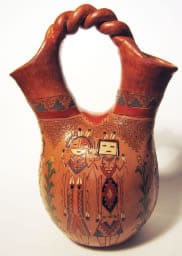Native Americans Continued to Remain Outsiders in the Postwar Years True False
3 Comments
Posted on February 24, 2019
The Lost Culture & Practices of the Native Americans: The Navajo
Before any imperialistic colonization of the North and South American regions took place, there was a time where different tribes of people lived in a peaceful environment, in harmony with others and nature. To outsiders, these people seemed to be ignorant and primal. In 1493, Christopher Columbus- a man who is accredited with the discovery of America- wrote this in his letter to the Spanish rulers Ferdinand and Isabella, who also happened to be his commissioners: "They [The Indians] are all, as I said before, without any sort of iron, and they do not have any weapons, which are unknown to them, and for with they are not adapted: not because of any bodily deformity, but because they are timid and full of terror." I would like to emphasize that Columbus claimed that the natives "were not adapted". This seems to serve as proof of the outsider-perspective that the native American people were underdeveloped and unenlightened compared to the evidently superior, knowledgeable, and righteous white man.
Perhaps not as a direct result of Columbus's expedition, but more as a result of the increasing desire of Western Europe to exploit the New World of its resources, the land and its native people were affected in extremely negative ways, being permanently altered. Given that an estimated 80-90% of all native American populations dropped drastically after the arrival of Columbus in the 15th and 16th centuries, (over 15 million Native Americans died), it would seem that Native American culture can never truly go back to its original state. Despite this gruesome fact, there are still some remaining tribes that have to try very hard to keep their culture and identity amidst modern attacks by the United States government and society.
The Navajo people have experienced this history firsthand. Split between the Navajo Nation and Colorado River Indian Tribe, it is the largest Native American reservation. The Navajo (or in their language, the Diné) had ancestors who were ice-age Paleo-Indian hunters in the years 12,000-6,000 BCE. These hunters dwelled in the modern-day Monument Valley region in Utah.

The region is classified as an arid desert, and would be very hard to live in for any modern-day human without technology or electricity. These hunters used special techniques in order to survive, such as foraging for edible plants. At the time, the domestication of animals did not exist, nor did subsistent agriculture. The Paleo-Indian hunters must have been in tune with their environment, and very aware of the impact and ecological footprint they were making. "Since hunter-gatherers could not rely on agricultural methods to produce food intentionally, their diets were dependent on the fluctuations of natural ecosystems." (khanacademy.org) In a desert environment, natural wildfires, or biological successions occur in order to cleanse the environment. These are the types of natural fluctuations that Khan Academy was referencing. The purpose of these successions is to give the land the opportunity to reproduce better with the repopulation of new seedlings.

This group of people needs to be very knowledgeable regarding their own ecosystem. It can be argued that they use their knowledge not only as a means to survive, but more importantly as a means to respect the land.
In continuation with time, the culture of the native people developed. In 1,100-1,500 AD, it is reported that the first signs of Navajo culture emerged.
"Long winter nights and the seclusion of the reservation
has brought about most of the customs and activities
used by the People to entertain and amuse themselves."
"The Navaho life is particularly rich in ceremony and ritual,
second only to some of the Pueblo groups."
"Almost every act of their life—the building of the hogán,
the planting of crops, etc.—is ceremonial in nature,
each being attended with songs and prayers."
Some important parts of the Navajo culture are their textiles, pottery, artworks, cultural legends, food, sand paintings, jewelry, and clothing. It is important to know that their culture has indeed changed over time, and has been greatly influenced by outsiders. For example, it wasn't until the 17th century when the natives were taught a specific weaving pattern by the Spaniards. Also, native women were supposedly encouraged by foreigners to make their weaving more marketable, so "Navajo women began to weave rugs instead of blankets; they had already replaced the blankets they wove for their own use with machine-made blankets…"
Here are some photos of these cultural items:






The Native Americans as a whole have been victims of westward expansion, and still are today. Even though the Manifest Destiny attitude has historically ended, there are still issues like globalization, technological advancement, and the ever-growing need for more land, that are endangering the culture of these natives.
In times like these, we must ask ourselves a question of priority. Is culture really that important?
Culture, in my mind, can be viewed as an endangered species. It is something precious. Once forgotten, culture cannot be remembered. Once dead, it cannot come back to life.
Perhaps, we can find answers to life's biggest mysteries not through more and more technological advancement, but through the ancient knowledge, beauty, and seemingly supernatural understanding that the Navajo People already have, and have always had since the very beginning.
Sources:
"Ancient Navajo and Native Americans Migrations." Navajo Code Talker, navajopeople.org/blog/ancient-navajo-and-native-americas-migrations/.
Carey, Harold. "Navajo People – The Diné." Navajo Code Talker, navajopeople.org/.
Leyden, Kimberly. What Was Columbus's Attitude toward the Native People of the Islands and How Did This Affect His Treatment of Them? . ucbhssp.berkeley.edu/sites/default/files/hssplessons/Columbus and Native Peoples Lesson.pdf.
"Paleolithic Societies." Khan Academy, Khan Academy, www.khanacademy.org/humanities/world-history/world-history-beginnings/origin-humans-early-societies/a/what-were-paleolithic-societies-like.
Source: https://sites.psu.edu/keepyourculture/2019/02/24/the-lost-culture-practices-of-the-native-americans-the-navajo/
0 Response to "Native Americans Continued to Remain Outsiders in the Postwar Years True False"
Post a Comment